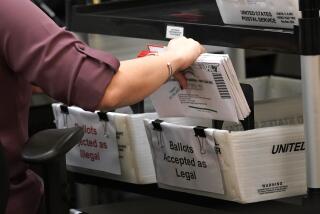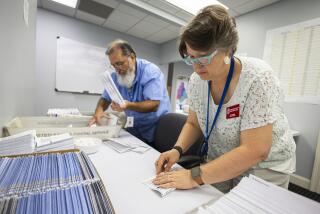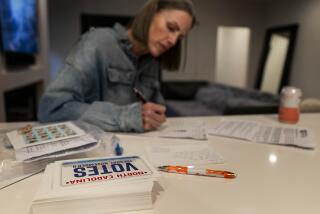Rapidly Changing Technology : Paper Ballots’ Days May Be Numbered
- Share via
In the rapidly changing world of computer technology, most of the nation’s electronic vote-counting systems are obsolete.
Punch-card balloting, like the Votomatic system used in Los Angeles County, is fast and inexpensive and the cards themselves provide an “audit trail” that can be followed in case an election result is challenged.
But some of Votomatic’s essential ingredients--the punch-card ballots and the machines that can read up to 1,000 ballot cards a minute--date back to what one expert called the “Stone Age of computers.”
Inasmuch as this technology is now used for little else than vote tabulation, election officials in Los Angeles and elsewhere worry about future availability of ballot pages, ballot cards and card-reading machines.
What will replace punch-card technology?
Some members of the election community wax enthusiastic about a future in which voters no longer troop to the polls but instead cast their ballots by telephone, computer terminal or cable television.
“I see a day when voters will vote from home, by phone or computer, and all the counting will be done centrally,” said Eeve T. Lewis, county clerk and registrar of voters in Sonoma County.
Technically Possible Amid Drawbacks
Some of these ideas are technically possible now but they have other drawbacks.
There are equity considerations--not everyone has access to cable television or computer terminals, for example--and there are security problems, because most of these systems could become tempting targets for computer “hackers” and would-be perpetrators of fraud.
In addition, maintaining the secret ballot would be difficult inasmuch as voters might be identified through telephones, computer terminals or television sets.
But one new approach is already at hand--Direct Recording Electronic (DRE), an all-electronic voting system that does away with printed ballots entirely.
The most widely used of these is the Shouptronic, manufactured by the R.F. Shoup Corp. of Pennsylvania, and used by about 80 election jurisdictions around the country (but not in California, where no DRE system has been certified).
In a Shouptronic booth, a voter is confronted by flashing red lights over the names of candidates and issues. Selections are made by touching the lights, which then go out, one by one, as votes are cast.
Results are recorded on both a tape and a cartridge, located in the back of the machine. When the polls close, the tapes and cartridges are taken to a central counting station, where the results from each polling place are read by a computer and totaled in a matter of minutes.
New York Switchover to Set Pace
Only about 3% of U.S. registered voters used DRE systems in the November, 1988, presidential election, but that figure will increase sharply if New York City follows through on plans to replace its 7,000, 26-year-old lever voting machines with the all-electronic devices, at a cost of $40 million to $60 million.
DRE eliminates most of the tons of paper that are produced by other vote-counting systems, sharply reducing the printing costs that are a major election expense. Because there are no ballots, there are no problems with “hanging chad”--small pieces that cling to ballots in a punch-card system, invalidating many votes and making it all but impossible to get the same result twice.
Compared to cumbersome, 750-pound lever machines, DRE devices are easy to handle and require less storage space. The Shouptronic weighs less than 200 pounds.
But DRE machines are expensive ($3,000 to $6,000 per unit) and they require the use of many telephone lines, which can create security problems. They cannot be used by the ever-increasing numbers of absentee voters.
Another major drawback is the lack of an “audit trail,” an independent record that can be checked in case of an equipment breakdown or a challenged result.
‘Much More Risky’ Than Current Systems
DRE is “much more risky” than current computerized tabulation systems because “you are fundamentally required to accept the logical operation of the machine--there is no way to do an independent check,” said Roy G. Saltman, of the federal government’s Institute for Computer Sciences and Technology.
Robert Boram, the engineer who designed the Shouptronic system, said it contains “five redundant memories” to check on accuracy.
But Saltman said “that is not an external, independent check” on the accuracy of the computer program.
Shoup and other DRE manufacturers are thinking about adding a feature to the machines that would provide a printed copy of each voter’s selections.
But Saltman said “that doesn’t solve the problem, because the computer could be lying.”
“DRE is at least a year and possibly two years away from what I would consider to be a marketable product,” said Robert J. Naegele of Santa Cruz, who has evaluated the all-electronic systems as a consultant for New York State. “The hardware problems are relatively minor, but the software problems are conceptual and really major.”
More to Read
Get the L.A. Times Politics newsletter
Deeply reported insights into legislation, politics and policy from Sacramento, Washington and beyond. In your inbox three times per week.
You may occasionally receive promotional content from the Los Angeles Times.










